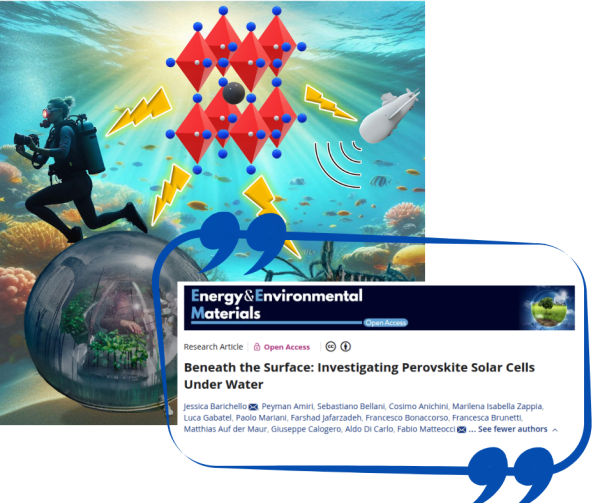Beyond traditional rooftop and building-integrated photovoltaics (BIPV), photovoltaic (PV) devices find applications in agrivoltaics, space, and indoor settings. However, the underwater (UW) environment remains largely unexplored. Below 50 meters, the solar spectrum shifts dramatically, with only blue-green light (400-600 nm) available. Perovskite solar cells (PSCs), known for their high-power conversion efficiencies (PCEs) and tunable bandgaps, offer potential for this environment. Initially, simulations compared the intensity of the solar radiation based on three models, each based on a different water body, down to a depth of 10 meters.
The trend of maximum theoretical performance, ranging from 1.5 to 3 eV band gap, was analyzed with respect to depth. In this pioneering study, a wide bandgap PSC, based on FaPbBr3, has been selected to operate underwater. Results were achieved through a complete in-house process encompassing fabrication, encapsulation, and underwater measurement. A 10-day saltwater submersion test of a damaged device confirmed minimal lead release, meeting stringent legal standards for lead in potable water.
PV performance was evaluated underwater, demonstrating enhanced conversion efficiency within the first few centimeters of depth compared to the device's performance at the surface.This enhancement is due to water's optical and cooling properties.
This work opens new frontiers for exploration, both for perovskites, traditionally considered unsuitable for humid environments, and for the increasingly human-occupied underwater realm, which is seeing the development of activities such as wine aging and plant cultivation.
The study was conducted by researchers of CNR-ISM in collaboration with researchers from the University of Tor Vergata, the company BeDimensional, and CNR-IPCF in Messina.
Tuesday, 01 July 2025 15:45
Beneath the Surface: Investigating Perovskite SolarCells Under Water
PV devices, beyond conventional rooftops, are finding emerging uses underwater, an unexplored environment. Below 50 meters, only blue-green light (400–600 nm) penetrates. Perovskite solar cells, known for their high efficiency and tunable bandgaps, show strong potential in this setting. Simulations and underwater testing of wide-bandgap FAPbBr₃ perovskite, demonstrated enhanced performance at shallow depths, supported by water’s optical and cooling properties. A 10-day immersion test confirmed minimal lead release. This study, published on Energy & Environmental Materials, opens new opportunities for underwater technologies.
Published in
Publications


 English (UK)
English (UK)  Italiano (Italia)
Italiano (Italia)